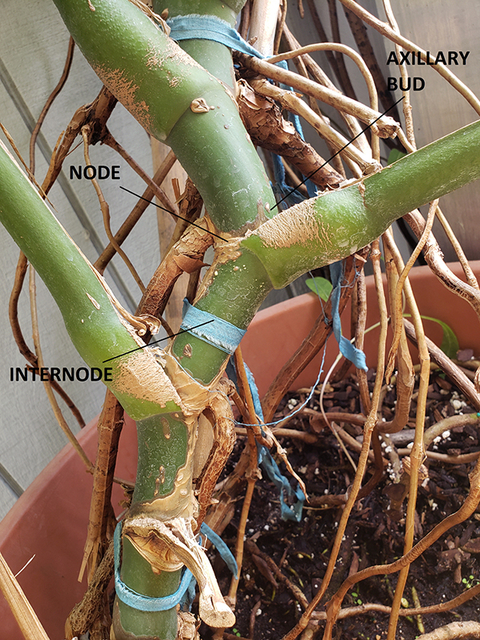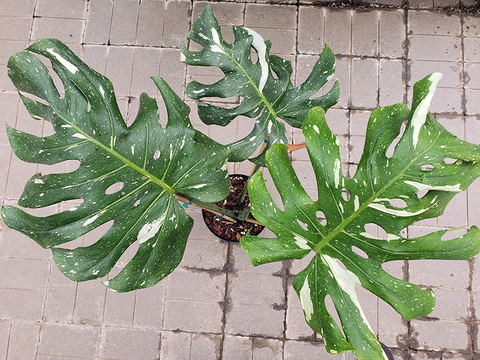Quick facts:
- An understory plant in its native Central America, Monstera deliciosa is a good houseplant for medium-light locations.
- Monstera deliciosa can only be propagated when the cutting includes a node.
- Propagated nodes can take up to 2 to 3 months before forming new leaves.
- Mature plants should be watered weekly, or when the top 1 to 2 inches of soil is dry.
- Monstera deliciosa rarely form flowers or fruit in environments outside of their natural habitat or controlled greenhouses.
Monstera deliciosa is commonly referred to as Swiss cheese plant, Mexican breadfruit, and hurricane plant. It grows as an understory plant in its native Central America and became a popular houseplant in the United States in the 1950s thanks to the plant's large, tropical foliage and ease of care.
Today, M. deliciosa is typically available wherever tropical houseplants are sold. Most varieties feature solid green leaves while the variegated forms are usually rarer.
Plant characteristics
In nature, the M. deliciosa is a vining plant, attaching to tree links and trunks with its aerial roots. A mature plant may reach more than 50 feet long and may be considered invasive in its native habitat.
M. deliciosa has distinctive leaves that are glossy green, heart-shaped, perforated, and deeply lobed and can reach up to several feet in width. Younger plants will lack perforations and deep lobes. M. deliciosa may be mistaken with the plant Thaumatophyllum bipinnatifidum (both were formerly in the genus Philodendron) and incorrectly called "split-leaf philodendron. " To help tell them apart, remember M. deliciosa's nickname: the Swiss cheese plant. Mature M. deliciosa plants have small holes in their leaves much like Swiss cheese whereas T. bipinnatifidum only has deep cuts.
Much like a peace lily or jack-in-the-pulpit (both belong to the same family as M. deliciosa: Araceae), M. deliciosa has a flower that consists of a white spike (spadix) and a sheath (spathe). As the sheath dies back, the spike transforms into a fruit. The fruit is ripe when the scales on the outside of the fruit start separating, showing the yellow-white flesh.
M. deliciosa do not form flowers or fruit as houseplants. While our homes may reach appropriate air temperatures, our indoor environments lack adequate humidity.
Propagation
Monstera deliciosa can easily be propagated from stem cuttings, air layering or division as long as each division includes a node (the point where a leaf develops on a stem). Cuttings that lack a node and axillary bud, such as the leaves, will not produce new growth and ultimately will rot.
The leaves and petioles of M. deliciosa will not grow on their own because new growth comes from axillary buds and nodes on the stem.
Cuttings may be taken at any time of year. We recommend supplemental lighting in the early morning or late afternoon for 2 to 3 hours and misting your plant every 2 to 3 days.
Propagation by stem cuttings
Follow these steps to ensure your Monstera deliciosa stem cutting roots successfully.
- Find a node with an axillary bud (refer to the Monstera propagation map).
Multiple leaves on your cutting promote better rooting through photosynthesis. - Cut 1 to 2 inches below the node, along the internode. If using auxin, rub along the cutting’s node.
- Moisten the rooting medium.
- Make a hole in the medium and insert your cutting.
- Keep cuttings moist.
- Check for root development by lifting your cutting carefully using a popsicle stick, plant transplant or small spatula.
- If roots are few or haven’t yet developed, put your cutting back into the medium.
- If roots have developed, you can transplant your cutting.
- Transplant your cutting into a new container filled with moist potting soil. Leave about 2 inches of media between your cutting and your container.
Rooting media
M. deliciosa can be propagated in a variety of media. The main purpose of rooting media is to maintain moisture and to support the cutting and its root development. It must also drain well to prevent the cuttings from rotting.
- Perlite: Provides support for the new plants, and oxygen and moisture to roots. Perlite is the most common medium used for Monstera deliciosa cuttings.
- Potting soil: This media can be purchased in garden centers, hardware stores and online. It provides support for new roots and good drainage.
- Potting soil should be kept moist to prevent the cuttings from drying out.
- Excessively wet, cool soil can cause damping off disease.
- Lightweight Expanded Clay Aggregate (LECA): Because of its excellent drainage, LECA can be watered more frequently without increasing the potential for damping off disease.
- LECA can be purchased online and at stores that specialize in propagation and hydroponics. It may be more expensive than other media, but can be reused.
- Water: Monstera cuttings can be rooted in plain water.
- Pros: In water, you can observe root growth, the plants are also easy to care for and they don’t require much space. The water should be changed when it becomes cloudy.
- Cons: Plant roots grown in water are weaker than those grown in solid rooting media. Woody plants such as citrus and hibiscus tend to rot when rooted in water.
Rooting hormone
Auxin is a plant hormone and a common plant growth regulator (PGR) that stimulates rooting, shooting, and blooming when propagating plants. Although auxin is found naturally within plants, applying auxin to a plant cutting can encourage cell division and improve the plant’s ability to develop longer root cells. Rooting hormone is available in powder, liquid and gel formats and can be purchased at garden centers and online.
Although M. deliciosa may root without additional hormones, auxin can promote faster rooting and dense root growth. Apply rooting hormone powder to the node before placing the cutting in the rooting medium. Auxin may also be added directly to water to encourage new rooting.
Containers
Containers of various materials and sizes can be used for growing plants: ceramic, plastic or resin pots, plastic food containers — there are few limits to what you can use.
Avoid containers that have been used for storing chemicals. Examples include pesticide containers, buckets used for asphalt sealant, and gasoline and oil cans.
When choosing a container for your cuttings, consider the size of your cutting, support and drainage.
- Monstera cuttings are top heavy, so select a heavier container to prevent tipping over. Containers might be made of terracotta, glazed ceramic or resin.
- Containers should be at least 4 inches in diameter and 5 inches deep. A one-quart nursery pot is also a good choice.
- Avoid containers that are too large as it is harder to gauge the moisture level of the media, which can lead to over or under watering.
- As a plant grows, transplant it into a slightly larger container.
- Provide support for your cutting until roots are formed.
- Stake your cutting by tying it to a bamboo stake with a piece of nylon stocking of cotton rag.
- When your cutting is successfully rooted and transplanted into a longer-term container, you can buy or build trellising to support and encourage your Monstera plant to climb.
- It is important to grow your cuttings in containers with good drainage.
- Your container should have at least one hole about the diameter of a pencil.
- Poor drainage and too much moisture can cause new roots on your cutting to rot.
Caring for your cuttings
For the first 1 to 2 weeks keep the potting medium continually moist. When you water, place the pot in a sink and allow excess water to drain. After the first week, allow the top of the soil to dry out between waterings.
Keep your cutting in a bright, warm location, out of direct sunlight.
- Place your cutting near windows that receive north and eastern light. Keep it away from windows in rooms that get direct southern or western sunlight.
- Roots will form in about 2 to 4 weeks.
- To check for roots, use a spatula, plant label or small trowel to gently lift your cutting out of its media. Inspect the roots. They should be creamy white and firm.
- If they are brown and soft, you are overwatering or your container is not draining well.
- A cutting with root rot may not survive and you may have to take a new cutting.
- Once healthy roots have formed, it is common to see new stems emerge and leaf growth every few weeks.
- If your M. deliciosa is propagated in late fall or early winter, supplemental light may be needed for about 2 to 3 hours each day.
- See Lighting for indoor plants and starting seeds.
When to transplant your rooted cutting
When healthy roots have formed and you observe active growth, it is time to transplant your Monstera into a larger pot for long-term growth. As your new plant grows, Monstera deliciosa should be repotted in late winter or early spring every one to two years.
Houseplants should be repotted into a larger container if:
- Roots are growing out of the bottom of your pot.
- The potting soil dries out within 24 hours.
- The plant has overgrown the container, causing it to tip over easily.
- You can easily lift your plant and the whole root ball out of the container (potbound).
- The plant is dull and seems to have stopped growing.
Choose a container that is about two inches wider than the current container. The new pot should be at least 1 to 2 inches taller than the current container.
About variegated Monstera
There are many variegated M. deliciosa varieties such as 'Thai Constellation', 'Albo Borsigiana', and 'Aurea' (or 'Marmorata'). These plants have unique white and yellow coloration caused by mutations during growth.
The mutations alter the amount of chlorophyll (the pigment that gives plants their green color) in different sections of the foliage causing unique patterns to form. Due to the lack of chlorophyll, energy from the sun is absorbed more slowly than in a fully green Monstera resulting in slower growth rates.
Some of these mutations alter the plant's foliage for its lifespan; others are temporary due to the instability of some mutations and the potential for non-variegated growth to outgrow variegation. The different mutations that can cause variegation can be quite rare (as low as a 0.001% chance) and expensive. They also can take a long time to propagate.
- Purchase healthy plants and seeds only from reputable companies and suppliers.
- Seeds do not contain variegation; the change in coloration is a mutation that forms after the seed has been germinated. So do not buy seeds that are claimed to be variegated.
- Cuttings should have at least one healthy node.
Crane, Jonathan H, and Carlos F Balerdi. “Monstera Growing in the Florida Home Landscape,” UF IFAS Extension, University of Florida, 6 Jan. 2020. https://edis.ifas.ufl.edu/publication/HS311#FOOTNOTE_1
Evans, Ervin, and Frank Blazich. “Plant Propagation by Leaf, Cane, and Root Cuttings,” NC State Extension Publications, NC State University, 31 Jan. 1999. https://content.ces.ncsu.edu/plant-propagation-by-leaf-cane-and-root-cuttings-instructions-for-the-home-gardener
Hessayon, D. G. (1992). The New House Plant Expert. pbi Publications.
Mahr, Susan. “Split-Leaf Philodendron, Monstera Deliciosa,” Wisconsin Horticulture, University of Wisconsin-Madison, https://hort.extension.wisc.edu/articles/split-leaf-philodendron-monstera-deliciosa/
Reviewed in 2024




